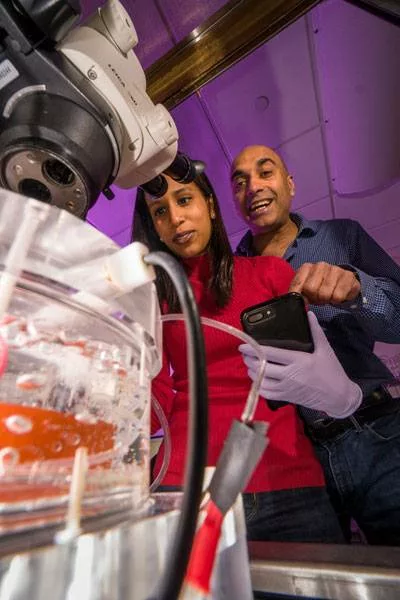Lily’s Fund Helps Assure Future Support for Epilepsy Research
Like many parents of children with intractable health issues, Dave Giroux routinely scanned the news with the hope of finding a new discovery to help his daughter, Lily, and others who are affected by epileptic seizures.
One day in 2006, he read a report about research into a substance that showed promise for quelling seizures. Further, he learned that the investigation was being done by University of Wisconsin School of Medicine and Public Health (SMPH) scientists — right in Madison, where the Giroux family lives.

“Dave soon realized he could look out the window of his office in Van Hise Hall and see our laboratory,’’ says Avtar Roopra, PhD, an associate professor in the Department of Neuroscience, who was collaborating with Thomas Sutula, MD, PhD, a professor in the Department of Neurology and the department chair at the time.
Dave Giroux and Anne Morgan Giroux trekked across Linden Drive to visit Roopra and Sutula’s lab in the Medical Sciences Center (MSC) to discuss what the couple could do to support epilepsy-related investigations. Following that meeting, the couple began making plans to create Lily’s Fund for Epilepsy Research, an effort to support scientists and studies at UW–Madison. The Giroux family’s initial Lily’s Fund donation has blossomed into an endowment that already has awarded $450,000 in grants to UW–Madison researchers.
The family’s vision, to put the “fun” into “fundraising,” led them to encourage their grassroots supporters to dress in grass skirts and Hawaiian shirts for the inaugural Lily’s Luau in 2009, at which they netted about $16,000. After raising $225,000 at its 10th and final luau at Union South in January 2018, Lily’s Fund has amassed a total endowment of more than $1 million to support epilepsy research at UW–Madison for years to come.
Equally important, the 10 years of Lily’s Luaus brought together a community of people united by a disease that affects one in 26 people. Over coconut shrimp at the tiki bar, revelers at the final luau bid on donated items and bonded over their desire to help find a cure for this life-threatening disease. At the “Science Shack,” luau participants also chatted with several epilepsy researchers, including Melanie Boly, MD, a clinical neurophysiology fellow in the Department of Neurology, who modeled a stylish electrode cap used to study the brain’s electrical activity.
Among the more than 800 guests swaying to ukulele tunes at the final luau were Robert N. Golden, MD, dean of the School of Medicine and Public Health, and his wife, Shannon Kenney, MD, professor, Departments of Oncology and Medicine, and Wattawa Bascom Professor in Cancer Research and leader of the virology program at the UW Carbone Cancer Center.
Addressing the jovial crowd, Golden said, “With federal support for research diminishing and becoming unpredictable, your support is more important than ever. But the inspiration you provide for our graduate students, post-docs and scientists is even more meaningful than a check from the federal government. And as a parent of a child with epilepsy: Mahalo. Thank you!”
A Critical Boost for Epilepsy Research
Looking back, the 2009 Lily’s Luau came at a crucial time for epilepsy research. With the nation in the depths of a deep recession and federal funding being slashed due to budget woes, the boost by Lily’s Fund has been critical in allowing several UW–Madison labs to maintain their focus on epilepsy research.
“Support of epilepsy research through Lily’s Fund has led to significant advances in knowledge and a greater understanding of the disease. Just as important, new findings are helping to frame the research questions that must be answered in order to explain variability in the symptoms and severity of the disease and to develop more effective treatments,” says Richard L. Moss, PhD, senior associate dean for basic research, biotechnology and graduate studies at the School of Medicine and Public Health. “The Giroux family’s vision and hope in establishing Lily’s Fund and enlisting partners in this cause are remarkable, as is their continuing dedication to increasing public awareness about the many dimensions of epilepsy.”
The first luau was a modest affair, with many of the Giroux family’s relatives and neighborhood friends making up the crowd of about 200.
“We were thrilled with the support,’’ Anne Giroux remembers of the event, held on a frosty January night in the Memorial Union’s Great Hall.

Among the participants was a couple, David and Colleen Penwell, who Dave and Anne Giroux had not met, but with whom they became fast friends and enthusiastic partners in this effort. The Penwells’ daughter, Grace, has a severe form of epilepsy called Dravet Syndrome.
The tireless work of Colleen Penwell and Anne Giroux, who have called each other co-pilots since they joined forces, helped grow the annual luau into its final glory. They also greatly raised the visibility of epilepsy on the UW–Madison campus and beyond. For instance, they created The Neuron Project, a lighted piece of public art that started as a fundraiser for Lily’s Fund and continues shining to honor donors’ loved ones with epilepsy.
Adorning the ceiling of the fifth-floor walkway between the towers of Wisconsin Institutes for Medical Research (WIMR) I and WIMR II, home to the neuroscience labs, this captivating display greets researchers daily as they come and go, and it provides a friendly purple beacon that can be seen from Highland Avenue even in the wee hours, while some scientists are still hard at work in their laboratories.
Throughout the past decade, Lily’s Fund took over the town with events large and small. Supporters held Lily’s Lemonade Stands on street corners and purple-cupcake fundraisers each year on March 26, Epilepsy Awareness Day. Lily’s Fund even made a big splash in Camp Randall Stadium during the 2014 Wisconsin-Minnesota football game, which was rebranded as “Badgers Axe Epilepsy.” Students waved purple Lily’s Fund bandanas during “Jump Around,” and players wore purple stickers on their helmets to honor former Minnesota coach Jerry Kill and the “One in 26” people who have epilepsy.

Along the way, quarters from lemonade stands, checks from The Neuron Project and donations from other fundraising efforts added up. This enabled Lily’s Fund to begin making a series of awards to fund three Lily’s fellowships that have allowed young School of Medicine and Public Health scientists — Beth Hutchinson, PhD, in 2011; Brandon Wright, PhD, in 2013; and Antoine Madar in 2015 — to focus on epilepsy research.
Touch of Grace
As Lily’s Fund grew, a series of $100,000 Grace Grants, named for Grace Penwell, also helped fuel epilepsy research at UW–Madison.
The first Grace Grant, in 2014, brought the expertise of world-renowned consciousness researcher Giulio Tononi, MD, PhD, director of the Wisconsin Institute for Sleep and Consciousness, to focus on epilepsy. Tononi and his research colleagues use high-density electroencephalography to track and analyze the brains’ electrical activity gathered when a subject sleeps while wearing a specialized cap with 256 electrodes. Most previous epilepsy studies have been done with far fewer electrodes, and thus they resulted in less complete data.
At the UW Epilepsy Monitoring Unit, research by Boly, Tononi, a professor in the Department of Psychiatry, and Rama Maganti, MD, a professor in the Department of Neurology, indicates that the electrical patterns in patients’ brains are altered in the days following seizures, and that seizures also induce long-term changes in brain activity.

“We found that patients with epilepsy show a deeper sleep than healthy controls, and that the depth of sleep is proportional to the amount of seizure activity during wakefulness preceding sleep — as if it were compensating for it,’’ says Maganti, who directs the UW Comprehensive Epilepsy Program and Electroencephalography Laboratory. “In contrast, epileptic spikes during sleep seem to decrease the efficiency of sleep.”
Boly, Tononi and Maganti published their findings in the journal Brain in April 2017. In 2015, Roopra received a Grace Grant, which was a game-changer for the way investigators in his laboratory study epilepsy. Using methods pioneered in cancer research, Roopra and his team, whose lab is now in WIMR II, took a deep dive into genomic data gleaned from 11 epilepsy laboratories around the world, sifting through 20,000 genes and looking for proteins that orchestrate the long-term changes in the epileptic brain, he explains.
That initial survey, funded with a $100,000 Lily’s Fund grant, generated data that allowed researchers in the Roopra lab to apply for and win two National Institutes of Health (NIH) R21 grants worth $275,000 each and a prestigious $250,000 Challenge Award from Citizens United for Research in Epilepsy.
Noting that data gleaned through research supported by Lily’s Fund helped the lab attain additional grants, Roopra says, “It really leap-frogged our research. A $100,000 grant is enough to prime the pump, and then everything else flows from it. The Lily’s Fund award came at the right time and allowed us to test our predictions.”
At the final Lily’s Luau, Roopra received a second $100,000 award, which is letting him further explore two master regulators of gene changes in epilepsy found in his research. One of them acts as a brake, protecting the brain from the damage of epilepsy. The other is an accelerator, driving pathological changes in the brain.
Meanwhile, Maganti received a second Grace Grant, along with Mathew Jones, PhD, an associate professor in the Department of Neuroscience, to look at how sleep deprivation triggers seizures. They also have applied for further NIH grants based on their Lily’s Fund work. Maganti’s recent research showed that epileptic mice in his lab suddenly die at a certain age, and he found in a study with his collaborator that rest periods (sleep periods) progressively decline prior to death in these mice, suggesting that sleep disruptions contribute to a dreaded complication of epilepsy known as “sudden unexplained death in epilepsy” (SUDEP).
Maganti and Jones’ Grace Grant-related work also showed that sleep deprivation in epileptic mice markedly worsens seizures or increases spikes on electroencephalograms (a signature of epilepsy), and their findings led to another NIH grant to study the basic mechanisms underlying sleep deprivationinduced seizures and how best these can be treated. They expect that this work will bring data from bench science to the epilepsy clinic.
“Seizures disrupt sleep, and disrupted sleep makes seizures worse,” Maganti told the Wisconsin State Journal in December 2017. “It can be sort of a vicious cycle.”
Maganti is hoping to study whether the use of medication to restore sleep can prevent SUDEP. These sudden deaths are likely triggered by seizures during sleep. Illustrating such a loss, a slide during the final Lily’s Luau paid homage to a young man with epilepsy, Jared Kimball, of McFarland, Wisconsin, who died in his sleep in 2017, just weeks after raising money at his workplace, Findorff Construction in Madison, to give to Lily’s Fund. As Kimball’s photo lit up the big screen, the words of Irish musician Glen Hansard reminded luau-goers that the fight continues:
“This gift will last forever,
This gift will never let you down …
If you’re strong enough,
And you don’t give up.”
Forever is a long time, but for years to come, Lily’s Fund certainly has elevated the profile of epilepsy research in School of Medicine and Public Health laboratories.
“To go from a few hundred dollars to fellowships, to grants of $100,000 and on to a research fund worth more than $1 million? I have never heard of this kind of success! It’s really a force of nature with these dedicated people,’’ exclaims Roopra. “Lily’s Fund made people aware that epilepsy is a major condition that is underfunded. I would have not pursued this line of research without Lily’s Fund. They were able to keep UW–Madison researchers on track and keep them in epilepsy research. Lily’s Fund deflected the trajectory of labs toward the study of epilepsy. That’s a major achievement!”